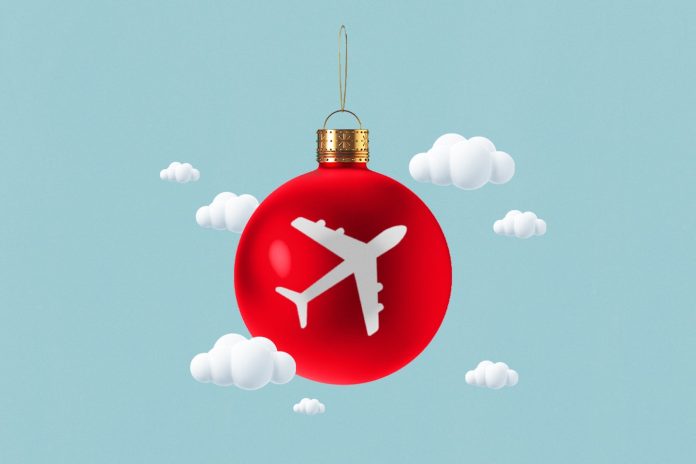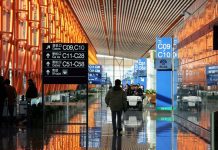Comment on this story
Comment
Christmas may be the most wonderful time of the year for many, but it’s historically been one of the worst if you’re at an airport or on the roads.
This year is set to be no exception. Nearly 113 million Americans are expected to travel at least 50 miles from home this holiday season, up about 3 percent from last year and approaching pre-pandemic figures, according to AAA. The majority, 102 million, will drive, but nearly 7.2 million plan to fly and 3.6 million plan to take a bus, train or cruise, according to AAA.
Still, travel is going to look different from 2019, with some Americans feeling the pinch of inflation and staying at home, while others will work remotely during their trips thanks to flexible work policies, said Mike Daher, vice chair and U.S. travel and hospitality lead at Deloitte.
“People want to be home with loved ones, and so they’re willing to take advantage of hybrid work to leave a few days early,” Daher said.
Here’s what to know about how holiday travel is shaping up in 2022.
Remote work is changing travel patterns
Daher said Deloitte’s research found that more than a quarter of travelers plan to work during their holiday trips this year, especially those under 55.
Working remotely allows them to travel for longer and take advantage of better airfare and hotel prices outside of the “very rigid holiday travel windows pre-pandemic,” he said.
Airlines have responded by spreading out their capacity over the holiday period, as opposed to the traditional peaks around the holidays themselves, according to John Elder, a partner focused on travel and tourism at Boston Consulting Group.
“That peak after New Year’s is far more subdued, and so there’s been more consistency in the seat volume in the days following New Year’s,” Elder said.
In addition, Christmas and New Year’s Day fall on Sundays this year, giving travelers an extra day at their destinations if they leave after work Friday, according to Hayley Berg, lead economist at the travel booking app Hopper. Hopper found that, on average, holiday travelers in 2022 are staying a day longer on domestic trips and are booking hotels for one night longer than last year, Berg said.
“This year, travel time will be extended due to Christmas Day and New Year’s Day falling on Sundays,” Paula Twidale, senior vice president for AAA Travel, said in a news release. “With hybrid work schedules, we are seeing more people take long weekends to travel because they can work remotely at their destination and be more flexible with the days they depart and return.”
You can still anticipate crowds at airports. Airlines have sold about 54 million seats between Dec. 18 and Jan. 3, up 20 percent from last year and 4 percent from 2019, according to Hopper. Air travel is expected to peak on the days immediately before Christmas Eve and the day after Christmas.
If you’re looking to avoid the crowds, travel on Christmas Eve or Christmas Day, or the middle of the week between Christmas and New Year’s. The Thursday and Friday before New Year’s Eve, as well as Monday, Jan. 2, will see large numbers of passengers, according to Hopper. The company recommends arriving at the airport at least two hours early and expecting long lines at security throughout the holiday period.
That’s especially true if you’re leaving from one of the nation’s busiest airports, which are expected to be Hartsfield-Jackson Atlanta International, Denver International, Dallas-Fort Worth International and Los Angeles International over the Christmas holiday, according to Hopper. Each are forecast to see more than 1 million passengers between Dec. 18 and Dec. 26, with crowds peaking between 8 a.m. and noon each day.
Fingers crossed for good weather
The Thanksgiving travel period — the busiest since the pandemic began — went as smoothly as airlines hoped, except for a few East Coast weather disruptions. U.S. airlines transported 22.2 million passengers over the Thanksgiving holiday, with less than 1 percent of flights canceled, according to Airlines for America, an industry trade group.
Aviation experts told The Washington Post last month that airlines have built more resiliency into their schedules and staffing since the chaos of summer travel. That bodes well for Christmas travel, they said, but weather remains an Achilles’ heel.
Just this week, the first significant snowfall of the year in Boston on Sunday left hundreds of Delta passengers stranded on planes sitting on the tarmac after landing. Delta told The Post in a statement that de-icing delays backed up both departing and arriving flights, and it reached out to affected customers with an “apology and goodwill gesture.”
Hopper forecasts the airports most likely to see disruption this holiday season will be Orlando International, Chicago Midway International and Palm Beach International in Florida. The company recommends booking the first flight out of the day to avoid getting caught in a domino effect of delays.
Avoid the busiest days on the roads
If you’re traveling by car, it’s best to avoid driving on Dec. 23, Dec. 27, Dec. 28 and Jan. 2, all days when holiday travelers will be mixing with normal commuter traffic, according to AAA. Travel times on those days can be up to 25 percent longer nationwide, with double the normal delays in major metro areas.
“With pre-pandemic levels of travelers hitting the road this holiday, drivers must be prepared for delays in and around major metro areas, with Tuesday, December 27 expected to be the nation’s worst day to travel,” Bob Pishue, a transportation analyst at the analytics firm INRIX, said in an AAA news release.
“Our advice is to avoid traveling during peak commuting hours. If schedules allow, leave bright and early or after the afternoon commute,” he added. Traffic is also expected to be minimal on Christmas Day, New Year’s Eve and New Year’s Day.
Domestic flights for the holidays are averaging around $339 round-trip, which is 15 percent lower than last year, according to Hopper. But if you haven’t booked your travel yet, you should do so now, because prices will start to rise about $10 per day in the final week or two before Christmas, according to the travel app.
There are still a few last-minute deals to be found. Round-trip tickets to Detroit and Oakland, Calif., are as low as $110, and Boston tickets are as low as $125 round-trip on Hopper. For travelers looking to go further afield, destinations under $300 round-trip include Providenciales in Turks and Caicos, San Juan in Puerto Rico and Montreal.
The key to finding a cheap flight is to be flexible on dates, such as by departing early the week of Christmas ahead of the peak travel days, according to Hopper. That may be possible for travelers who can take advantage of remote work.
Berg said in an email that Hopper’s research found that 66 percent of customers plan to travel more often because of remote work in 2023 and that 41 percent plan to travel on non-weekend days for cheaper prices.
“Flexible workers are also likely to take advantage of lower prices when traveling midweek or on off-peak dates,” Berg said. “As travel prices are expected to remain high into 2023, these savings could go a long way.”













